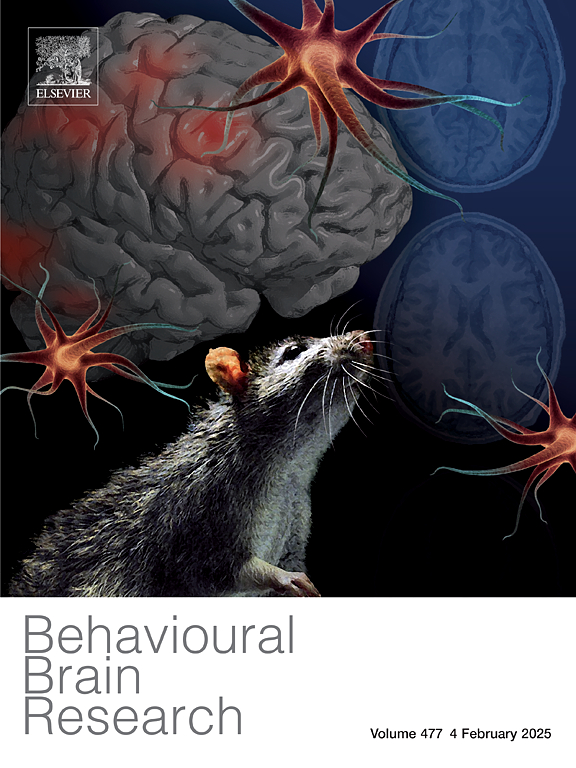Prefrontal and ventral striatal dendritic morphology: Effects of life-long complex housing and amphetamine administration
IF 2.6
3区 心理学
Q2 BEHAVIORAL SCIENCES
引用次数: 0
Abstract
Complex housing is one of the most effective experiences in producing plastic changes in the brain. For example, animals living in complex environments show widespread synaptic changes both in cerebral cortex and the striatum. Similarly, repeatedly treating animals with drugs such as amphetamine also induces changes in prefrontal cortex and the striatum. The purpose of the current study was to determine the effects of life-long housing in a complex environment versus standard laboratory caging and the later effects of amphetamine. Both male and female Long-Evans rats were placed in complex environments for about 110 days, beginning at conception, until adulthood at which time they were administered saline or amphetamine daily (1 mg/kg, IP) for 14 days. A week later the brains were harvested and processed for Golgi-Cox staining to analyze dendritic length, branching, and spine density in prefrontal cortex (areas Cg3 and AID) and Nucleus Accumbens (NAcc). Prolonged enriched housing produced significant synaptic changes in all three measures in all three areas measured, but the effects differed in the two sexes. Amphetamine produced large synaptic changes in Cg3 and NAcc in males but only spine changes in those regions in females. Complex housing did not interact with the later effects of amphetamine administration. Thus, both complex housing and amphetamine can produce a range of synaptic changes depending upon sex and area examined. Furthermore, the effect of complex housing varies depending on the details of when complex housing is begun and how long it lasts.
前额叶和腹侧纹状体树突形态:终身复杂住房和安非他明管理的影响。
复杂的住房是在大脑中产生可塑性变化的最有效的经验之一。例如,生活在复杂环境中的动物在大脑皮层和纹状体中都表现出广泛的突触变化。同样,反复使用安非他明等药物治疗动物也会引起前额皮质和纹状体的变化。当前研究的目的是确定在复杂环境中终身居住与标准实验室笼子的影响以及安非他明的后期影响。从受孕开始,雄性和雌性Long-Evans大鼠在复杂环境中放置约110天,直到成年,然后每天给予生理盐水或安非他明(1mg/kg, IP) 14天。一周后,采集大脑并进行高尔基-考克斯染色,分析前额叶皮层(Cg3和AID区)和伏隔核(NAcc)的树突长度、分支和脊柱密度。长时间的强化住房在所有三个测量区域都产生了显著的突触变化,但在两性中效果不同。安非他明在雄性小鼠中引起Cg3和NAcc突触的大变化,而在雌性小鼠中只引起脊柱的这些区域的变化。复合住房与安非他明给药的后期效果没有相互作用。因此,复合住房和安非他明都能根据性别和检查的区域产生一系列突触变化。此外,复杂住房的效果取决于复杂住房开始的时间和持续时间的细节。
本文章由计算机程序翻译,如有差异,请以英文原文为准。
求助全文
约1分钟内获得全文
求助全文
来源期刊

Behavioural Brain Research
医学-行为科学
CiteScore
5.60
自引率
0.00%
发文量
383
审稿时长
61 days
期刊介绍:
Behavioural Brain Research is an international, interdisciplinary journal dedicated to the publication of articles in the field of behavioural neuroscience, broadly defined. Contributions from the entire range of disciplines that comprise the neurosciences, behavioural sciences or cognitive sciences are appropriate, as long as the goal is to delineate the neural mechanisms underlying behaviour. Thus, studies may range from neurophysiological, neuroanatomical, neurochemical or neuropharmacological analysis of brain-behaviour relations, including the use of molecular genetic or behavioural genetic approaches, to studies that involve the use of brain imaging techniques, to neuroethological studies. Reports of original research, of major methodological advances, or of novel conceptual approaches are all encouraged. The journal will also consider critical reviews on selected topics.
 求助内容:
求助内容: 应助结果提醒方式:
应助结果提醒方式:


